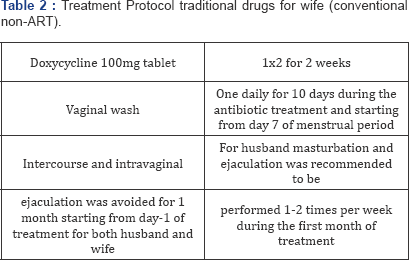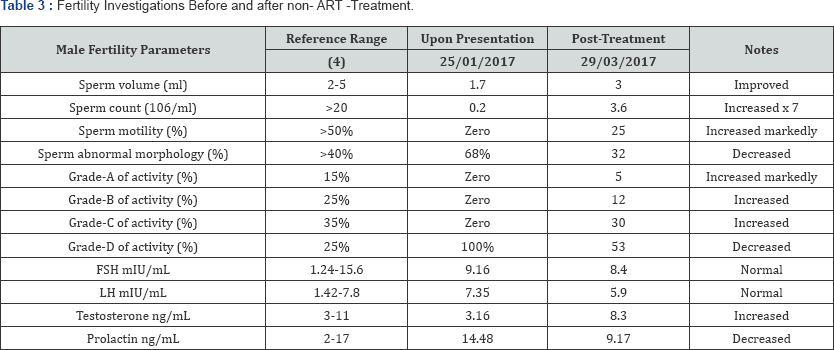Spontaneous Pregnancy after Conventional non- Assisted Reproductive Therapy of Male Infertility ® due to Sever Oligoasthenoteratozoospermia - Case Report
Global Journal of Reproductive Medicine Juniper Publishers
Abstract
A 34-years-old man was diagnosed with primary infertility of 12 years duration due to severe oligoasthenoteratozoospermia (OATS). His hormonal profile was normal. Patient was treated for 2 months using traditional drugs (conventional non-assisted reproductive therapy). After 2 months, spontaneous pregnancy was diagnosed based on an evidently increased β-human chorionic gonadotropin (β-hCG) level in his wife’s blood. The pregnancy was confirmed by transabdominal ultra sonography where a gestational sac with ~7 weeks viable fetus was observed and documented. In conclusion, severe OATS can be successfully treated by conventional non-ART therapy.
Keywords: Oligoasthenoteratozoosperiam; Male infertility; Spontaneous pregnancy; Conventional drugs
Abbreviations: NON-ART: Non-Assisted Reproductive Techniques; IVF: In vitro Fertilization; OATS: Oligoasthenoteratozoospermia
Introduction
Infertility is a worldwide health problem and it is considered as one of the most common health disorders among young adult couples [1]. According to our previous study, male infertility was found to be responsible for —1/3 (29.9 %) of infertility cases (1281/2622) and the percentage of OATS was around 7% (183/2622) [2]. Jo and Ja Kang in 2016 reported that in 30-45% of male infertility cases, the cause of the abnormal semen parameters was hesitant. But Jo & Ja [3] were reported also treatment of OATS is standardized approach for the dealing with idiopathic male infertility but it remains elusive. On the other hand, traditional treatment of OATS by non-assisted reproductive techniques (non-ART) is still not standardized. Regarding the conventional oral therapy (oral therapy by antibiotics and antioxidant) of male infertility due to OATS, a gap in published reviews was noted in the last decade. Furthermore, the conventional ART therapy is still expensive and usually used as the last option of infertility treatment. In this case report, we successfully treated a patient with male infertility due to severe OATS which we called it oral therapy or conventional nonassisted reproductive therapy (non-ART therapy) for infertility treatment. It is the policy of our In vitro Fertilization (IVF) Center to give a chance for anti- inflammatory, anti-bacterial and supportive therapies before embarking on ART therapy
Case Report
A 34-year-old man was presented to IVF Center on 25/1/2017 with primary infertility of 12 years duration. No history of testicular injury, varicocele, torsion/hydrocele, cancer and chemotherapy was found after thorough questioning. Physical examination revealed normal vital signs with a BMI of 23.5kg/ m2, bilaterally palpable vas deferens, and normal masculine habitus with no signs of gross abnormalities. He was married to 32-years-old-lady who was apparently reproductively fertile i.e., all infertility investigations were done and shown to be normal. Verbal consent was taken from the couple prior to sending this case report for publication.
Semen analysis
The semen analysis was investigated on the first visit (patients already familiar with procedures of infertility centers and from the first visit they are usually ready to collect semen analysis for investigation) to the clinic with sexual abstinence period of 3-5 days. Semen was collected in the outpatient semen- laboratory in a sterile plastic. In the analysis, the volume was measured using a graded tube and the sperm count was done by the manual slide method. Motility was scored as percentages of:
A. Fast forward progressive,
B. Slow forward progressive,
C. Non-progressive and
D. Immotile spermatozoa in total number of 200 counted spermatozoa in at least five power fields per replicate, according to the WHO manual [4].

His wife was treated by a two weeks course of doxycycline and vaginal wash. At the same time they were advised to avoid intercourse during the course of treatment and the husband was asked to do masturbation and ejaculation at least 1-2 times per week, Table 1 & 2.

A. Fast forward progressive,
B. Slow forward progressive,
C. Non-progressive and
D. Immotile spermatozoa in total number of 200 counted spermatozoa in at least five power fields per replicate, according to the WHO manual [4].


Results
After conventional non-ART treatment of this case, an improvement in the semen volume, sperm count and motility were noted and reported, Table 3. Active grade 1 motile sperms were recorded. On 25th May, 2017, the couple reported a one- week missed-period. During transabdominal ultrasound, a normal gestational sac of 6-7 weeks with viable fetal pool was noted. Pregnancy was confirmed by positive laboratory result for the presence of 2,798.011U/mL serum beta human chorionic gonadotropin.



Comments
Post a Comment